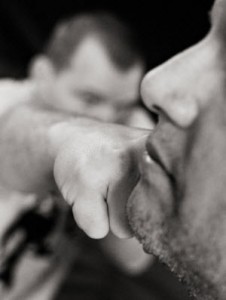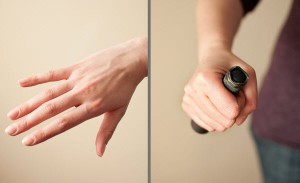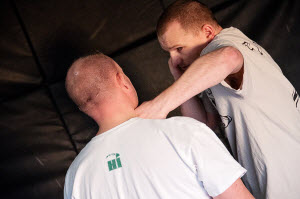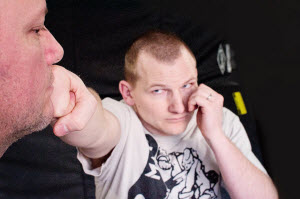
With the rise of MMA, more people than ever are training with the closed fist. These skills can be just as useful when the gloves come off.
www.personaldefensenetwork.comThe Hips
No discussion of striking, or any form of combat on foot, is complete without addressing the hips. Power, speed, agility, and athleticism in general can all be tied back to the hips. Imagine the meanest turbo-charged sports car on the road stocked with an engine that puts out horsepower beyond your wildest dreams. Now imagine if no one bothered to put a transmission in it. That’s what a fighter would be like if he were in the best shape of his life and didn’t understand how to use his hips: beautiful, intimidating and utterly useless.
The hips are the transmission of the human body. They transfer power from one region to the next: legs to core, core to legs. Think about one of your legs: alone, it can only generate force up or down. The hips can take that up/down force and translate it into rotational force, lateral force, anywhere in 360°. The hips can also act as a motion buffer between your lower and upper platforms, making your actions smoother and harder for an attacker to anticipate. I cannot overstate the role of the hips in generating smooth, fast, and powerful punches. More on this later.

If the length of your fingers prevents you from making a proper fist, consider using an object to fill the space. Dual-purpose items like lights and small impact weapons are excellent choices.
www.personaldefensenetwork.comThe Fist
A correct fist is formed by laying the fingers against each other, placing the fingertips into the center crease of the palm, and wrapping the thumb tightly across the space between the last two knuckles of the middle and index fingers. A good fist should have no open space in it. To prevent damage to the thumb, it must be kept tight, outside the fist and away from the striking surface of the knuckles. Allowing the thumb to point forward, or worse yet extend outward in the “hitchhiker’s” position, can cause impact to isolate in the thumb and result in painful injury. No one appreciates the phrase “sticks out like a sore thumb” more than someone who’s made this error.
Most of us can naturally form a decent fist without much instruction, but one issue that must be addressed, especially for people with long fingers, is filling the center of the fist. Empty space inside the fist allows the hand to deform on impact, and that’s when things can get broken. Boxers and MMA fighters in competition eliminate this issue by forming a “bar” through the center of the fist with tape or wraps. Out in the world, our attackers are unlikely to wait patiently while we tape up, so learning to form as tight a fist as possible becomes even more important. If you’re among the few whose fingers are too long to form a tight fist, you should consider a small impact weapon such as a palm baton to fill that space. Remember, the ideal is that your fist will deform less so that your attacker’s face can deform more.
The Wrist and Arm
Another important aspect of form is position of the wrist and arm in relation to the fist. Imagine your arm as a hammer. The knuckles are simply the face, but the head of the hammer is the entire fist and forearm from the knuckles to the elbow. The handle is the elbow to the shoulder. The head of a hammer doesn’t bend. When all the bones, knuckle to elbow, are naturally aligned, the amount of force you transfer into your opponent is increased.
The most common injury I see resulting from a misaligned wrist and forearm is rolling and spraining of the wrist. The most common cause is when a combatant “aims with the knuckles,” tilting his or her fist toward the target instead of orienting the forearm and fist as one unit. Watch for this and correct it in your training. Trust me: tilting that fist toward the target doesn’t get it there any faster.

A lead hook to the neck is a fast and effective punch. Practice will ensure that your Line of Force and Line of Impact consistently align.
www.personaldefensenetwork.comLine of Impact vs. Line of Force
An under-addressed topic in striking is the Line of Force of a blow and how it relates to the Line of Impact. Line of Impact (LOI) is the angle of motion over which a punch contacts and travels through a target. Line of Force (LOF), however, is the line of motion through which the maximum actual force of the blow is transferred. LOF can be thought of as the “center of gravity” of a punch. Whenever possible, the LOF and LOI of a strike must occur in the same plane of motion. This is especially important on strikes like the hook, overhand, and uppercut, which impact from an angle. If the elbow isn’t moving in the same plane as the fist, it will rock through on impact and bleed off force that would be better spent dumped into your opponent.
The small bones in the back of the hand, called the metacarpals, absorb most of the impact from a punch and are therefore the likeliest to break. (Breaks in the fourth and fifth metacarpals, the pinky and ring fingers, from a poorly thrown punch are so common they’re referred to as “Boxer’s Fractures.”) Biology tells us these bones are crudely cylindrical in shape, and physics tells us a cylinder is strongest on the long axis. Remember when your teacher stabbed a soda straw through a potato in science class? It’s like that.
How you orient the elbow behind the fist when you punch will determine whether you impact on the ends of the heavier second and third metacarpals or at an angle with the weaker fourth and fifth. Don’t believe me? Make a good fist and hold it in front of you, palm side inward like a hook with your forearm parallel to the floor; you in the back, you too. Put the flattened palm of your other hand over the first two knuckles. Now hold your palm in position as you lower the elbow of your striking arm. Your point of impact changed to the knuckles of the ring and pinky fingers, didn’t it? Understand that properly aligning the LOF and the LOI in a strike is one of the two most important principles for avoiding injury when striking with the bare fist. The other is targeting.
Targeting
I believe the only thing that causes more injury to the bare fist than poor form is poor targeting. Untrained combatants, whether fueled by fear and frustration or anger and alcohol, tend to revert to what has been called the Universal Fight Plan: clench the fists and throw haymakers until someone disengages or takes enough damage to no longer be a threat. It’s sloppy, ugly, usually goes to the ground, and unless taught otherwise, almost everyone does it. As warriors, you should strive for far greater efficiency and skill than the mere default setting of man.

Our hands tend to follow our line of sight. Looking at your target through the moment of impact will increase your precision.
www.personaldefensenetwork.comI shouldn’t have to say it, but where you strike the head matters. You can strike most of the body with low risk of injury to the hand, but the human skull is a minefield of heavy bone. It should come as no surprise that the box you keep your brain in is well reinforced. But the fact that the brain is in the head is the best argument for hitting it. So how do we get around the body’s natural defenses?
Imagine your attacker is wearing a watch-cap covering the crown of the head from the top of the ears and eyebrows around to the base of the skull. The parts of the skull covered are the hardest: the frontal bone, crown and sides of the skull are essentially bony plates. The exposed area of the face contains the smaller bones of the nose, orbits, jaw and teeth. Primary targets are the center of the face from the bridge of the nose to the tip of the chin, and the chin-strap of the jaw from ear to ear. These are the areas to target as they are the most likely to deform with impact and provide the most damage for your effort.
Other good targets are the sides of the neck from the ear to the collar. The neck, being less dynamic than the head, is often easier to hit. The meatier structure also lowers the risk of injury to the hand while still transferring enough impact to the inner ear to be painful and disorienting.
Essential Punches
As we review these techniques, we’re going to keep coming back to the hips. All the punches described are initiated through the hip driving your striking-side leg into the ground and resulting in sharp rotational force in the core of the body. The motion begins with a slight lowering of your center of gravity. This is “sitting down on the punch” and it allows your legs to coil momentarily in preparation for explosive force. The force of a straight punch like the jab or cross will be tangential to the motion of your core, and hooks will be parallel. This is all just a fancy way of saying that you need to hit him with force gathered from as much of the body as possible: legs, hips, core.
The Jab
The jab is a fast straight punch performed with the non-dominant hand.
Drive the lead foot into the ground and pop the lead hip toward the target.
Allow the fist to rotate as the jab extends to facilitate a straight trajectory through your line of sight. Rotation may be as little as 45° or as much as 180°. What matters is that the motion is natural, keeps the bones in the forearm, wrist and hand aligned, and presents the striking surface of the knuckles with as little deviation between LOI and LOF as possible.
All motions are performed explosively and in concert. Don’t forget to breathe.
The Cross
The cross is a powerful straight punch performed with the dominant hand.
Drive your strong-side foot into the ground and drive through your strong-side hip. As your body torques, the fist leaves its place protecting your head and moves straight to the target. As your fist travels, your shoulder should come up to protect your jaw. While generally less pronounced than in the jab, the fist again rotates to facilitate a straight trajectory to target through your line of sight. The straighter this punch is thrown, the more powerful the impact. Ideally, you should be able to visually observe impact over the two primary striking knuckles without any torque felt in your wrist or hand.
Remember: explosive and concerted.
The Hook
The hook is a powerful, sharply looping punch performed with either hand. I would suggest that most of the broken hands in street encounters result from badly thrown hooks striking the thick parts of the skull. This is largely due to the fact that the extent of their training is the six times they watched the fight scenes in Road House. The hook does take a little more practice than the jab or cross (especially with the lead hand), but it is a great weapon and you would be well served to learn it.
As your hip initiates the hook, the elbow flares upward until the forearm and fist are parallel with the ground. At the same time, the fist drifts away from the head just enough to establish a trajectory perpendicular to line of sight with the target.
At this point, the fist should orient with the palm inward to maximize natural alignment and increase the odds of impact along the primary striking knuckles. Drive the fist through with the power of your legs and core and then bring it back to protect your head.

Defend as you attack by keeping the off hand up and raising the striking-side shoulder to protect the jaw.
www.personaldefensenetwork.comConclusions
By practicing and giving attention to proper form and targeting, the bare-knuckle striker can use his fists against a threat with little risk of injury to the bones of the hand. In addition, making proper form a consistent part of your training will improve the power, accuracy and repeatability of your punches. As with all skill development, consistency in practice and a willingness to self-critique and self-correct are of the utmost importance.

when i was taught over the summer after i graduated high school. i got a one way tick to hawaii. there i took a karate class once a week for 2 months or so. i was told to be twisting the wrist as you punch and you are suppose to hit with the first 2 big knuckles. also to punch threw what ever you were punching at. practice practice and practice. never broke any bones in my hand but broke noses , knocked teeth out. now i am older and i have plenty of problems. there is nothing unfair in a fight, you only have one thing to do and that is win the fight the best way you can. if it means really hurting someone that is the way it is. go for it and keep going. try to stay out of the fight if you can, but if you cannot put everything you have into it. you should never throw the first punch. if you do you have assaulted him. it does leave you at a disadvantage but an assault charge is not good either/
This was a very enlightening for me. I had everything about bare fist fighting all wrong!
Having fought for a number of years and, or decades ago( twice on TV) and loosing a split decision to Armando Muniz who went on to win the welterweight title, bare knuckle fighting can indeed be dangerous to the fingers and hands so making a tight fist is a must. However, if the opportunity should prevail itself, hitting an attacker with an open palm under the nose driving his nose to the top of his head is an excellent start as is jamming your finger beneath the throat in that indented area which will almost in all cases bring an attacker to the ground or his knees at which point you can either retreat or finish the encounter quite speedily if necessary.
Excellent article. Very informative and useful. Would welcome more of the same. I also understand Diesel's response having some experience in martial arts. Thank you Johnny
Combat, fighting, in a controlled enviornment is unpredictable and in personal defense more unpredictable. As a boxer/kickboxer with 35 years of experience, the last thing I advise is punching with a fist in a street/self defense confrontation. This suggestion is especially true when a trained puncher, capable of generating more force, is the target of agression. Breaking one's hand/wrist is the most likely outcome when your opponet, who has the same reactions as non-perps, ducks his head and your strike his skull instead of his jaw. Open plam strikes to the face and ear avoids this mistake. An ear strike with an open palm will disorient the largest opponent. An elbow to the face is more destructive than an unprotected ungloved fist. Leave punching with a fist to the ring.
Hi, most of this instruction is very good. With the comment about someone's thumb being to long is just nuts, you fold your tumb over your knuckles at a 90° angle. Plus I've yet to meet someone whose fingers are to long to make a fist unless their palms are very small and apparently have "deformed" hands. Plus they're not going to have time to pack their fist with a "baton" when a fight breaks out. When I used to street fight, we used to pack our fist with a Bic lighter. I also was an accomplished boxer, who was good enough to compete for the Golden Gloves in my area, but a torn ACL ruined that chance for me from a different sports injury. You are completely correct about the hips, and as my trainer used to tell me "put your ass into your punches" because the glutes are some VERY strong muscles. Every thing else is great instuction. Thank you.
Nice refresher from boxing 101, on all the body mechanic basics...excellent for those that have a understanding...👍
good description of punching and fist arm form. Eyes, necks, and shins are 3 targets I advocate for.
very informative
Good techniques shown.